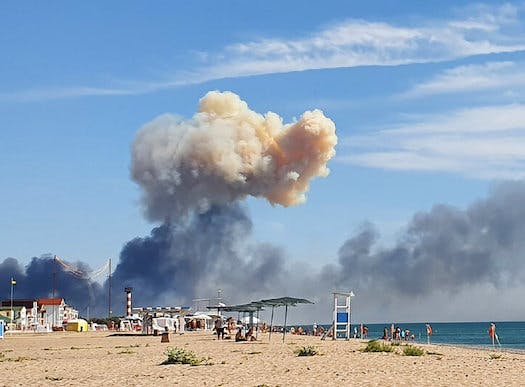Russia’s Losses at Crimea Base Might Mark Turning Point for Ukraine
The attack is evidence that Kyiv and its leadership are far from ready to cede any territory to the Russians.

The destruction of a Russian base at Crimea this week is a major military achievement that may also help Kyiv convince outside skeptics that the most consequential conflagration on European soil since World War II can end in victory for the West.
Questions abound over how Russia’s Saki air force base at Crimea was almost completely destroyed. Satellite images released hours after the attack show three deep craters at the base, major fire damage to its installations, and at least eight destroyed warplanes on the ground.
Kyiv is not confirming or denying its role in the attack, which Moscow claims was an accident while denying any planes were damaged. At the same time, military analysts are puzzled over the method behind the operation, and what hardware was used.
Based on the almost perfectly identical diameters of the three craters, several military analysts suggest that the Ukrainian military may now possess a new and advanced missile or aircraft. If so, that such a weapon managed to evade S-400 air-defense missiles deployed around the base should worry the Russian army.
Other observers cite the craters’ depth and the charred images to suggest that the raid was done by a team — local saboteurs or members of Ukraine’s special forces — that managed to infiltrate the base somehow and smuggle in powerful explosives that destroyed the aircraft and the base’s fueling depots.
According to a widely followed Twitter account specializing in open source intelligence, Evergreen Intel, the depth of the craters point to a “special ops job.”
Beyond questions about the attack, its location is significant. Saki is one of Russia’s most important air force hubs in Europe. It’s situated just north of Russia’s main Black Sea naval base at Sevastopol, which only last week was attacked by Ukrainian drones. Crimean beaches are favored by Russian tourists, who most summers are attracted by the area’s tranquility.
Perhaps obliterating several aircraft that were parked on runways does not amount to a decisive blow akin to Israel’s destruction of the entire Egyptian air force in the first hours of the 1967 Six-Day War, yet the strike has strategic ramifications.
Russia’s military took Crimea by force in 2014. Moscow declared the peninsula its own shortly afterward. Much of the world, including America, dismissed the annexation as a side show fraught with complex historical roots, which merited no more than weak statements of condemnation on a Kremlin land grab.
No longer. Russia’s follow-up to the Crimea invasion was February’s launch of a war against the entire state of Ukraine. That invasion united Western Europe, many former Soviet countries, and America against President Putin. Yet, even that unity has its limits.
In May, a former secretary of state, Henry Kissinger, told a conference at Davos that negotiations to end the war must start soon, and that, “Ideally, the dividing line should be a return to the status quo ante.” European leaders agreed, and urged Kyiv to cede its eastern Donbas region in order to speed up peace talks.
While the ultimate fate of Donbas is hotly debated among Europeans, most of them consider the Russian possession of Crimea a done deal. The idea that Ukraine could militarily affect the eight-year Russian presence there seemed far fetched.
If the latest attack on the Russian air base was conducted by local guerrillas, it suggests that many pro-Ukrainian patriots remain on the peninsula. If so, Russia may not be as deeply entrenched in Crimea as previously thought.
Conversely, if the attack featured some kind of new missile, that too should worry the Russians. Hitting a base that is well defended by air and is situated some 180 miles from Ukraine’s territory is no small feat. It suggests that Kyiv has the means to harm the invaders even where they previously thought themselves to be fully protected.
It also is evidence that Kyiv and its leadership are far from ready to cede any territory to the Russians. It should signal to would-be peace mediators that even as Ukraine is under heavy Russian pressure, including carpet bombongs of Kharkiv and other large cities, Kyiv is in no mood to compromise, either on the eastern region or even on Crimea.
It may even turn the tide in the West, where many have long preferred appeasement to a prolonged war against Russia. This week the Pentagon announced a package of $1 billion in military aid to “meet Ukraine’s critical security and defense needs.”
Whether that assistance could prompt a Ukrainian victory remains to be seen. Yet, it signals that President Biden is becoming more aware than he initially was of the centrality of the war to America’s competition with a Russian-Chinese-Iranian axis attempting to seize world leadership.
Victories in single battles rarely win wars, yet this setback for Russia could become a point that turns the political and military tides in Ukraine’s favor.

